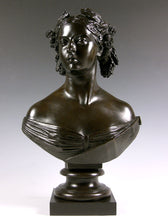Bronze Bust of Queen Victoria, Circa 1855-60
Adding product to your cart
Height: 35cm (13.75in)
Queen Victoria portrayed with her head turned to the right and with a wreath of oak leaves and acorns - symbolic of power and authority - in her hair, and with a rose, a thistle and a shamrock - representing the Union of Great Britain and Ireland - to either side; attired in low-necked dress with and sash of the Order of the Garter.
The present bust derives from the full scale marble in the Royal Collection by the London-based, Italian-born, French-educated sculptor Baron Carlo Marochetti of Vaux. The original marble bust was commissioned by the queen as a birthday present to Prince Albert in 1855. Later, and as a result of Prince Albert’s interest in the industrial arts, the firm of Minton received permission to reproduce the bust in reduced scale in the accessible medium of Parian. It is acknowledged, however, that Marochetti was resistant to such reproductions, being protective of his high bronze prices.
Read more
Pietro Carlo Giovanni Marochetti (1805-1867) was the son of a lawyer in the service of the Napoleon I. He was raised in Paris and became a French citizen in 1814. He trained as a sculptor under Bosio and Gros at the École des Beaux-Arts before completing his studies in Rome. A glittering career ensued. He produced numerous portrait busts and genre groups in marble and plaster, and became celebrated for his magnificent bronze equestrian statues of Emmanuel Filiberto in Turin (1833); The Duke of Orleans, Paris; and Richard the Lionheart in London (1860).
A popular figure amongst European Royalty and their courts, he moved to Britain shortly after the Revolution of 1848, accompanying the deposed French King, by whom he was introduced to Queen Victoria and Prince Albert for the first time in 1849, impressing the queen, who found him ‘very agreeable, gentlemanlike and unassuming’ (quoted by Ward-Jackson, Queen Victoria, journal, 1 July 1848, Royal Archives, Windsor). Marochetti soon became their favourite sculptor. After the Prince Consort's sudden death in 1861 it was Marochetti who was asked to carve his marble effigy - and that of the queen (added to the monument after her death forty years later) - for the Royal Mausoleum at Frogmore. Marochetti’s privileged position, however, created resentment among British-born sculptors, especially when in 1856 he received the valuable commission for a monument at Scutari to the fallen of the Crimea without a preliminary competition.
Reference
Ward-Jackson, P. (2012), ‘Victoria & Albert, Art & Love, Public and private aspects of a royal sculpture collection.’ Royal Collection Trust.






